Wondering how many of you have stayed out at night close to elk that you found at sunset so that you would be right there at sunrise to get after them? Without walking back to spike camp or truck camp that is. A guy I met one time, much tougher than me of course always carried his camp on his back and made big loops thru the mountains, camping wherever he ended the day whether it was on elk or not. He didn't use a tent, he just crawled under a pine tree and toughed it out in his sleeping bag. I remember an old episode where Randy and the cameraman did it and had to cover up with game bags and pine bows to TRY to stay warm. If my memory is correct they nearly froze! I usually have a small tarp and warm enough clothes in my pack that I could survive the night if needed, I've just never tried it. (Have to find elk first  ) I'm sure a small fire would help if you were far enough away from the targeted elk. Any success stories or advice?
) I'm sure a small fire would help if you were far enough away from the targeted elk. Any success stories or advice?
Navigation
Install the app
How to install the app on iOS
Follow along with the video below to see how to install our site as a web app on your home screen.
Note: This feature may not be available in some browsers.
More options
You are using an out of date browser. It may not display this or other websites correctly.
You should upgrade or use an alternative browser.
You should upgrade or use an alternative browser.
"Camping" on elk?
- Thread starter Muskeez
- Start date
2rocky
Well-known member
- Joined
- Jul 23, 2010
- Messages
- 5,202
There are some places where over night with no fire and light gear is certainly doable. A 30 degree bag and bivy sack is roughly the size of a loaf of bread in your pack.
I'd try it on a summer scouting trip first.
My past successes where I found elk at sunset involved me coming at them early in the morning, often from a different direction because of thermals.
I like dropping my camp and doing loops out from there in 3 different directions then move if no joy. No point in carrying 4-5 days worth of food too...
But that said there is always good reason to pack enough for an unexpected overnight stay. MRE and some bedding insulation.
I'd try it on a summer scouting trip first.
My past successes where I found elk at sunset involved me coming at them early in the morning, often from a different direction because of thermals.
I like dropping my camp and doing loops out from there in 3 different directions then move if no joy. No point in carrying 4-5 days worth of food too...
But that said there is always good reason to pack enough for an unexpected overnight stay. MRE and some bedding insulation.
I have. One night I followed a herd until dark, ended up being 3 miles from my camp but only 1 mile from my truck. ended up going to the truck and spending the night zipped up in a giant military duffel bag to stay warm. Another time I was camped and the bugles drove me nuts so I got up at 3AM and got close and crashed under a tree until it was light out. I was a lot younger and ambition was higher back then. Part of it was being solo with no one to talk to at camp anyway.
treedagain
Well-known member
- Joined
- Dec 9, 2011
- Messages
- 536
Twice in Colorado for 1st season bulls in OTC areas. Both ended in legal shooting light kills on 6point bulls.
ashersdad
Well-known member
Did it once in Wyoming when I didn’t want to go all the way back to camp. I wasn’t prepared and had to build a fire half way through the night to keep from freezing.
I’d definitely do it again IF prepared. For some reason I tend to learn things the hard way.
I’d definitely do it again IF prepared. For some reason I tend to learn things the hard way.
elkantlers
Well-known member
I never get more than a few hundred yards from my Truck so it has never been an issue for me.
Probably why antelope is your favorite species to hunt right? Shootem right out of the truck. That’s a good way to stay fat.I never get more than a few hundred yards from my Truck so it has never been an issue for me.
elkantlers
Well-known member
Probably why antelope is your favorite species to hunt right? Shootem right out of the truck. That’s a good way to stay fat.
I've got a lead-sled bolted to the hood of my truck.
LuketheDog
Well-known member
Did it last fall from the truck, does that count? A friend drew a 'premier' unit here, which I was unpleasantly surprised to find channeled most of the hunters onto one side of the unit due to access and geography, so it nuked our premade plans. We spent all afternoon of the day before opener glassing down the canyons from various knobs and points with no elk spotted but lots people, and finally located three good bulls way, way down in the bottom of a deep canyon right before dark, only 500-600 yards from the main road in a spot that everybody else was overlooking somehow. I threw the tipi out right there above the elk in a nasty, crappy, dusty spot right next to the road, the kind of place nobody wants to camp, and I told him "This is camp, about 6 hours from now we're going get up, drop all the way down that canyon in the dark and sit there until the sun comes up, and you're going to shoot one of those bulls at first light"...and he did.
Last edited:
D
Deleted member 39961
Guest
I've done two nights without a bag in september at 10k on a pad, it was fine, but it was cold.
I've camped on elk in scree fields, down timber, etc. Only if it syncs with wind. Often it does if you can find a nook to tuck into.
I've camped on elk in scree fields, down timber, etc. Only if it syncs with wind. Often it does if you can find a nook to tuck into.
COEngineer
Well-known member
- Joined
- Jul 6, 2016
- Messages
- 1,565
I think the trade-off is how much the extra weight of a bag/pad/bivy limits how far/fast you can go and not having to walk all the way to/from camp to get back to the elk. I have not stayed out overnight (away from spike camp), but I have raced up a mountain to get to some elk before dark.
If you had a super light setup and/or were in tremendously good shape, it could definitely be a good option.
If you had a super light setup and/or were in tremendously good shape, it could definitely be a good option.
Muley_Stalker
Well-known member
No need to do it with how I hunt. Plus, my dog is at home and I need to take care of him.
ShootsManyBullets
Well-known member
The SO tipi with stove makes doing stuff like that pretty comfortable. We just vacuum seal and freeze a good meal or 2 to reheat and skip the mountain house as much as possible.
Always up hill
New member
- Joined
- Jan 27, 2020
- Messages
- 4
Did it a few times in Idaho and Montana . Just one thing to remember is the thermal change in the evening and morning. Making sure not to send sent the wrong way. One little tip... Hammocks Are cheap and light. being off the ground in a nice warm bag can get a guy some nice sleep
Last edited:
Southern Elk
Well-known member
We once had elk bugling all night right outside the tent. Got up, walked 100yds from camp, called a bull in at first light, and my buddy missed a 40 yd shot.
noharleyyet
Well-known member
Hunkered solo on a herd the night before opener a few years ago....would have worked but their internal clock was 20 minutes fast the next morning.
Last edited:
I have spent at least dozen or so nights out in the woods that I hadn't initially planned for. Most of them were in relatively nice weather during September or early October. I have a hard time sleeping anyway, but without a pad or sleeping bag it all but guaranties a lot of tossing and turning. Since I will be waking up a lot anyway, I try to keep a little fire going to keep me warm through the night. This is a lot easier to do if you have buddy or two along to take turns. I used to think that making a fire while hunting was a no-no, but since I have started making fires while hunting I have actually had much better luck. Could just be luck or more experience on my part, but I think part of it is that I stick out glassing spots longer when I am comfortable and feel better rested in the mornings after going to bed warm and dry. As long as you can make and keep a fire going, you can live through some pretty cold and miserable nights. Helps to have some heat reflecting/containing structures opposite the fire from you and behind you. A rock face, big log, or up under a big spruce works pretty good. If you have some ingenuity, motivation and time, you can often build some kind of structure to help shelter you from the elements.
Here is a shelter that we built after some nice bulls lured us further back into the mountains. We knew that if we hiked out that night we wouldn't be able to make it back the next morning. This little meadow had a bunch of old downed trees along the edges that were rotten in the middle but the outer rings were still pretty solid. We were able to peel a bunch of big strips off of the logs and brace them against a small leaning tree. We left the middle of one side open above where we put the fire. We didn't have any warm layers and although it got down into the mid 30's that night, we all stayed warm in there. Usually I don't make anything quite that fancy, but with three of us there it went up pretty quick.
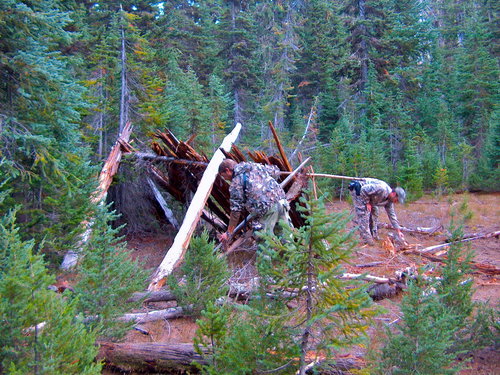
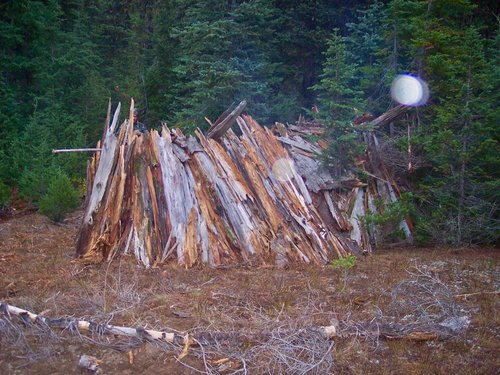
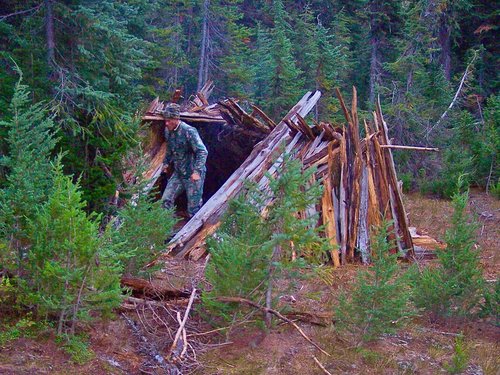
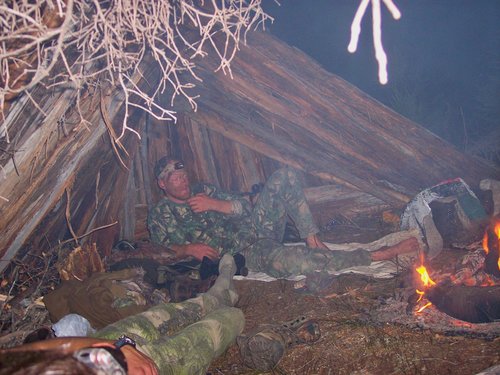
Here is a shelter that we built after some nice bulls lured us further back into the mountains. We knew that if we hiked out that night we wouldn't be able to make it back the next morning. This little meadow had a bunch of old downed trees along the edges that were rotten in the middle but the outer rings were still pretty solid. We were able to peel a bunch of big strips off of the logs and brace them against a small leaning tree. We left the middle of one side open above where we put the fire. We didn't have any warm layers and although it got down into the mid 30's that night, we all stayed warm in there. Usually I don't make anything quite that fancy, but with three of us there it went up pretty quick.




My cousin is friends with a guy that is an expert in primitive survival/living off the land. He takes in a handful of students for a few months at a time and does several "trips" throughout that time. I had the opportunity to tag along on one of these outings where we walked from the Powder River to the Tounge River in SE Montana. This was in mid March. It never got above freezing during the day and the local rancher that ran our vehicle shuttle said that it got down below zero on two of the nights we were out there. We only had a surplus military blanket for sleeping. We started all our fires with a hand or bow drill and made all of our water by boiling snow in a couple communal pots over the fire. All we had for food was dried lentils, beans and a little rice (I get migraines so I cheated and brought enough protein bars to have one each day). Not going to say that it was the most pleasant experience of my life, but it was definitely a great learning experience. I come out of it feeling much more confident in my survival skills, and the realization that as long as I can start and keep a fire going I can stay alive for a long time. I know I said that in my last post, but I think it is worth repeating.
Here are a few pics of some of our camps from that trip.
This night we camped in somewhat of a cave formed where some house sized chunks of rock broke off of a cliff and came to rest against each other. This provided good heat reflective surfaces around us, but little wind protection since the "cave" was open at both ends. The big plus of this spot was the easy to dig sandy soil and access to lots of fist to melon sized rocks. We heated the rocks in our fire then buried them in the sand under where we slept. This works decent to keep your downward side warm for a few hours, especially if you can lay a tarp on the ground above them. The tarp helps trap the heat and the rocks stay warm longer.
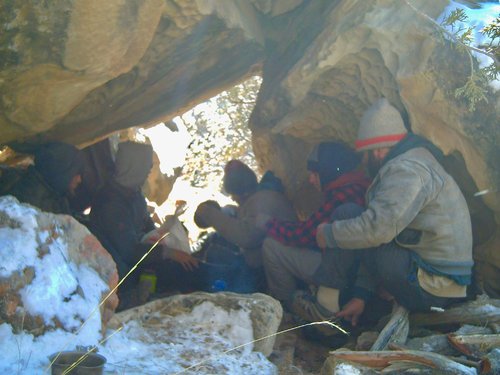
For this camp we found a tight little draw that we could lay a couple of logs across so that they spanned the distance at about waist height. We left about a six foot gap between these logs for the fire then leaned smaller logs/branches on the outside of the spanner logs to form two lean-to's facing each other. We ran out of light and easy logs so for one side we used our ponchos/tarps. On top of that we added a bunch of pine needles and duff for insulation. This also can work as insulation under and around you in a pinch. There were six of us, but with 1-3 people you would only need to make one side.
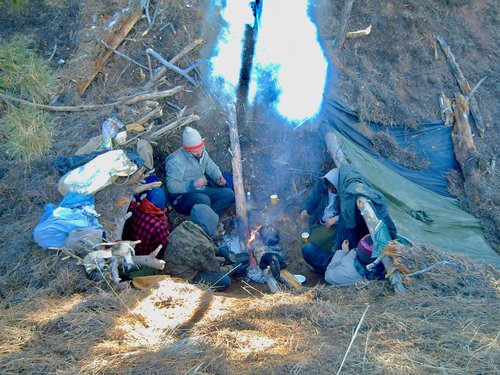
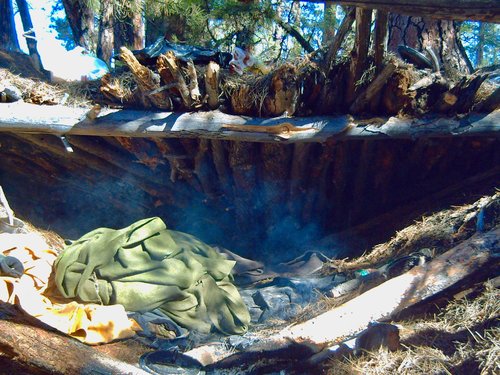
Thew this one in so you could see the homemade packs everyone was using. That is, everyone but me...thankfully right before the trip one of the other guys pack broke and he used the spare that was set aside for me. I felt a little bad at first that I was the only one with a normal pack, but not at all by day three. This things worked ok, but not my preference for 15-20 miles a day for six days.
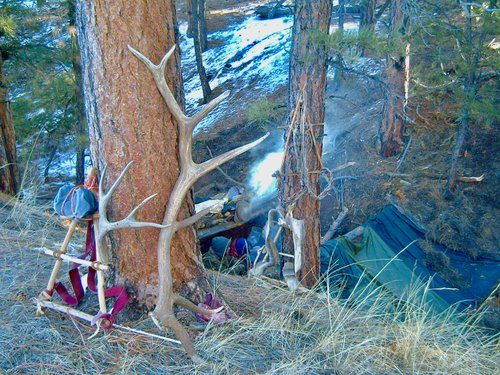
This spot and primitive camping technique resulted in by far the best nights sleep of the trip. We found a long cliff face with sandy soil at the base. We each dug a trench about 6 feet long, 2-3 feet wide, and 10-12 inches deep. We got a fire going then transferred some burning sticks into each of our trenches where we had piled a bunch of firewood. You want to get a good fire going with large pieces of wood. Let it burn down a bit and make sure you have somewhat large pieces of smoldering wood before spreading it around the trench and covering it with the sand/dirt you excavated out of the trench earlier. It is not necessary, but once again it makes the warmth last much longer if you have a tarp to lay on the ground. If you have a large enough tarp you can fold it in half and lay on one half and drape the other half over you. Our beds were still warm in the morning.
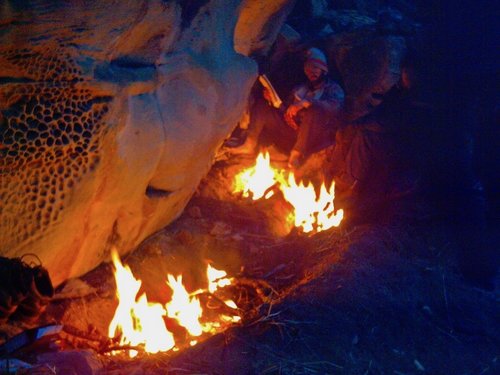
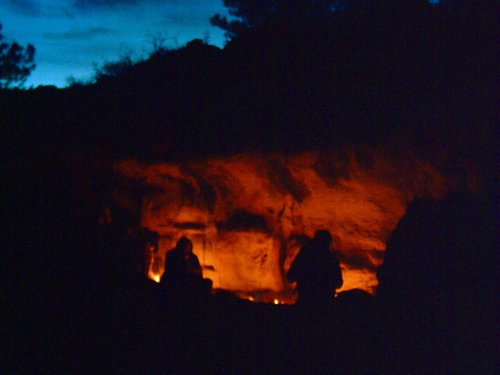
Here are a few pics of some of our camps from that trip.
This night we camped in somewhat of a cave formed where some house sized chunks of rock broke off of a cliff and came to rest against each other. This provided good heat reflective surfaces around us, but little wind protection since the "cave" was open at both ends. The big plus of this spot was the easy to dig sandy soil and access to lots of fist to melon sized rocks. We heated the rocks in our fire then buried them in the sand under where we slept. This works decent to keep your downward side warm for a few hours, especially if you can lay a tarp on the ground above them. The tarp helps trap the heat and the rocks stay warm longer.

For this camp we found a tight little draw that we could lay a couple of logs across so that they spanned the distance at about waist height. We left about a six foot gap between these logs for the fire then leaned smaller logs/branches on the outside of the spanner logs to form two lean-to's facing each other. We ran out of light and easy logs so for one side we used our ponchos/tarps. On top of that we added a bunch of pine needles and duff for insulation. This also can work as insulation under and around you in a pinch. There were six of us, but with 1-3 people you would only need to make one side.


Thew this one in so you could see the homemade packs everyone was using. That is, everyone but me...thankfully right before the trip one of the other guys pack broke and he used the spare that was set aside for me. I felt a little bad at first that I was the only one with a normal pack, but not at all by day three. This things worked ok, but not my preference for 15-20 miles a day for six days.

This spot and primitive camping technique resulted in by far the best nights sleep of the trip. We found a long cliff face with sandy soil at the base. We each dug a trench about 6 feet long, 2-3 feet wide, and 10-12 inches deep. We got a fire going then transferred some burning sticks into each of our trenches where we had piled a bunch of firewood. You want to get a good fire going with large pieces of wood. Let it burn down a bit and make sure you have somewhat large pieces of smoldering wood before spreading it around the trench and covering it with the sand/dirt you excavated out of the trench earlier. It is not necessary, but once again it makes the warmth last much longer if you have a tarp to lay on the ground. If you have a large enough tarp you can fold it in half and lay on one half and drape the other half over you. Our beds were still warm in the morning.






